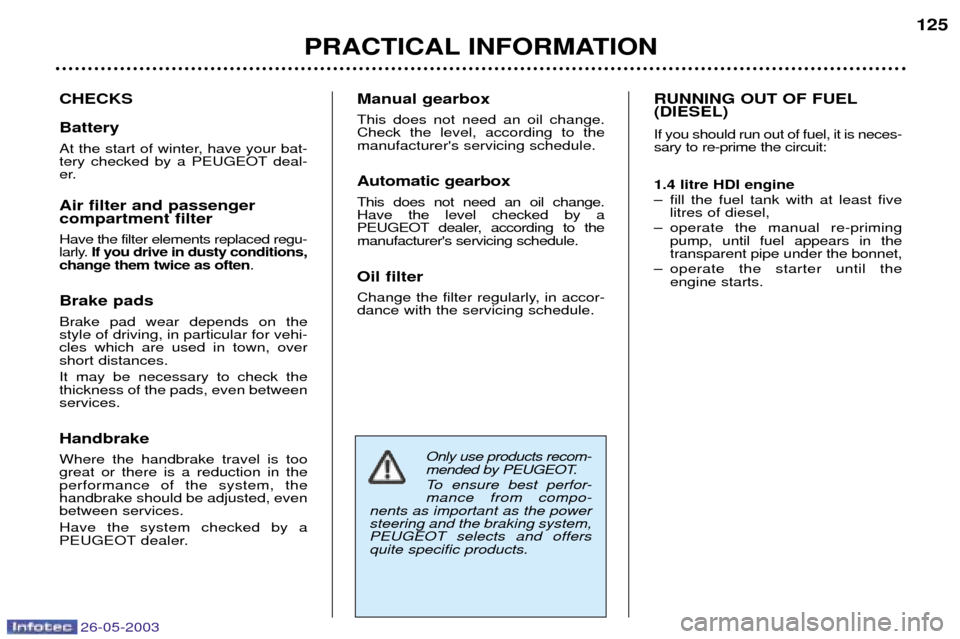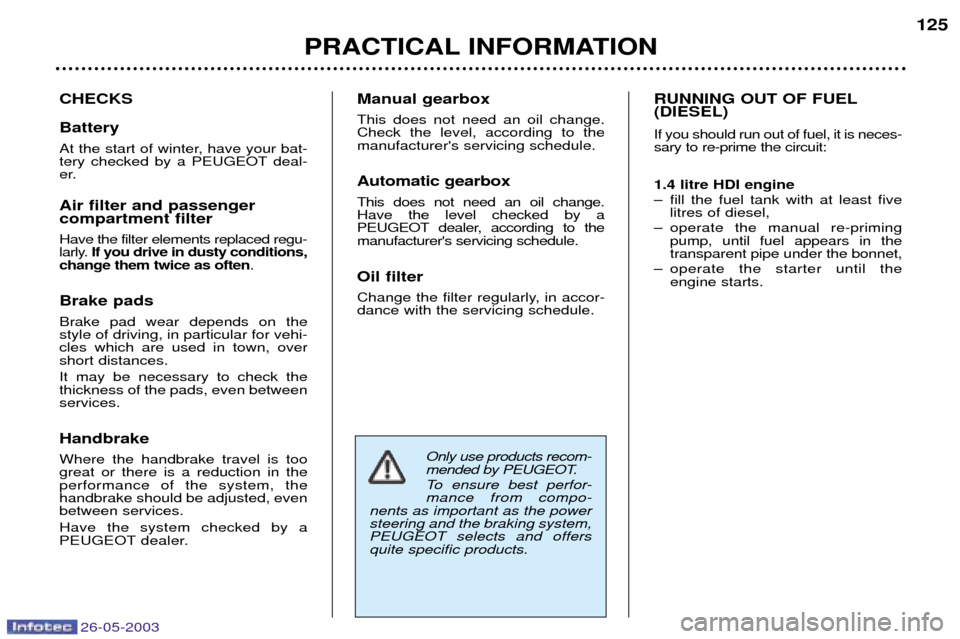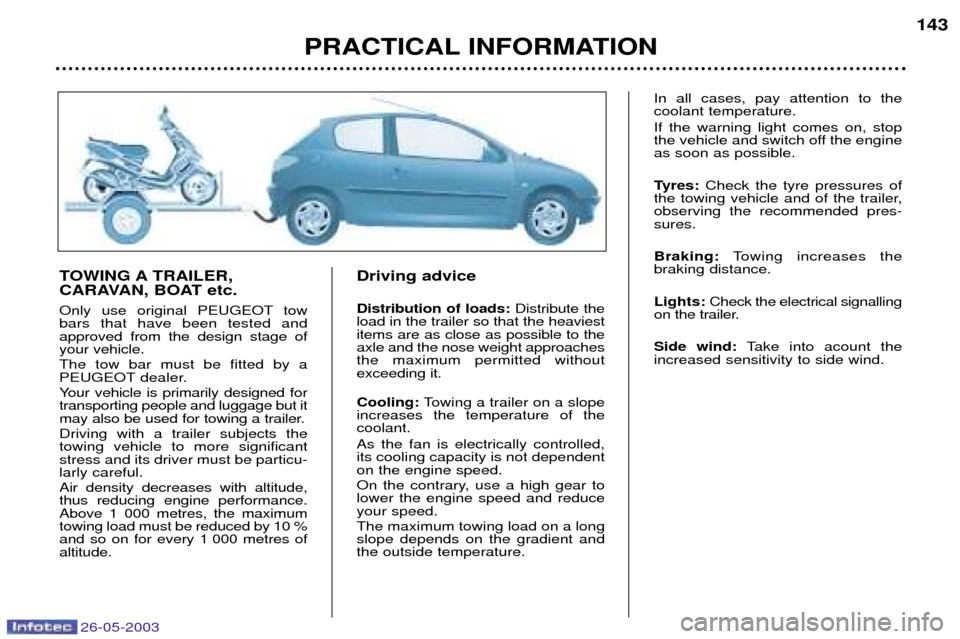check engine Peugeot 206 SW 2003 User Guide
[x] Cancel search | Manufacturer: PEUGEOT, Model Year: 2003, Model line: 206 SW, Model: Peugeot 206 SW 2003Pages: 171, PDF Size: 2.12 MB
Page 135 of 171

26-05-2003
PRACTICAL INFORMATION125
CHECKS Battery
At the start of winter, have your bat-
tery checked by a PEUGEOT deal-
er. Air filter and passenger compartment filter Have the filter elements replaced regu-
larly. If you drive in dusty conditions,
change them twice as often .
Brake pads Brake pad wear depends on the style of driving, in particular for vehi-cles which are used in town, overshort distances. It may be necessary to check the thickness of the pads, even betweenservices. Handbrake Where the handbrake travel is too great or there is a reduction in theperformance of the system, thehandbrake should be adjusted, evenbetween services. Have the system checked by a
PEUGEOT dealer. Manual gearbox This does not need an oil change. Check the level, according to themanufacturer's servicing schedule. Automatic gearbox This does not need an oil change. Have the level checked by a
PEUGEOT dealer, according to themanufacturer's servicing schedule. Oil filter
Change the filter regularly, in accor- dance with the servicing schedule.
Only use products recom-
mended by PEUGEOT.
To ensure best perfor- mance from compo-
nents as important as the powersteering and the braking system,PEUGEOT selects and offersquite specific products.
RUNNING OUT OF FUEL (DIESEL) If you should run out of fuel, it is neces- sary to re-prime the circuit: 1.4 litre HDI engine
Ð fill the fuel tank with at least five litres of diesel,
Ð operate the manual re-priming pump, until fuel appears in the transparent pipe under the bonnet,
Ð operate the starter until the engine starts.
Page 136 of 171

26-05-2003
PRACTICAL INFORMATION125
CHECKS Battery
At the start of winter, have your bat-
tery checked by a PEUGEOT deal-
er. Air filter and passenger compartment filter Have the filter elements replaced regu-
larly. If you drive in dusty conditions,
change them twice as often .
Brake pads Brake pad wear depends on the style of driving, in particular for vehi-cles which are used in town, overshort distances. It may be necessary to check the thickness of the pads, even betweenservices. Handbrake Where the handbrake travel is too great or there is a reduction in theperformance of the system, thehandbrake should be adjusted, evenbetween services. Have the system checked by a
PEUGEOT dealer. Manual gearbox This does not need an oil change. Check the level, according to themanufacturer's servicing schedule. Automatic gearbox This does not need an oil change. Have the level checked by a
PEUGEOT dealer, according to themanufacturer's servicing schedule. Oil filter
Change the filter regularly, in accor- dance with the servicing schedule.
Only use products recom-
mended by PEUGEOT.
To ensure best perfor- mance from compo-
nents as important as the powersteering and the braking system,PEUGEOT selects and offersquite specific products.
RUNNING OUT OF FUEL (DIESEL) If you should run out of fuel, it is neces- sary to re-prime the circuit: 1.4 litre HDI engine
Ð fill the fuel tank with at least five litres of diesel,
Ð operate the manual re-priming pump, until fuel appears in the transparent pipe under the bonnet,
Ð operate the starter until the engine starts.
Page 156 of 171

PRACTICAL INFORMATION
140
BATTERY
To charge the battery using a battery charger:
Ð Disconnect the battery,
Ð Follow the instructions for use given by the battery charger manufacturer,
Ð Reconnect starting with the negative (Ð) terminal,
Ð Check that the terminals and connectors are clean. If they are covered withsulphate (white or greenish deposit), disconnect them and clean them.
To start the vehicle from another battery:
Ð Connect the red cable to the positive (+) terminals of the two batteries,
Ð Connect one end of the green or black cable to the negative (Ð) terminal of the slave battery,
Ð Connect the other end of the green or black cable to an earth point on the bro- ken down vehicle as far as possible from the battery,
Operate the starter, let the engine run.
Wait for the engine to return to idle, then disconnect the cables.
Ð Before disconnecting the battery, you must wait for 2 minutes after switching off the ignition.
Ð Never disconnect a terminal when the engine is running.
Ð Never charge a battery without first disconnecting the terminals.
Ð Close the windows and sunroof before disconnecting the battery. If they do not operate normally following reconnection of the battery, they must be reintialised (see sections "Electric windows - Safety auto-reverse" and"Sunroof - Safety auto-reverse".
Ð After every reconnection of the battery, switch on the ignition and wait 1 minute before starting to allow the electronic systems to be initialised. Ifslight difficulties are experienced after this, please contact a PEUGEOT
dealer.
It is advisable to disconnect the battery if the vehicle is not to be used for a period of more than one month.
ECONOMY MODE FUNCTION After the engine has stopped, with the key in the accessories position,
certain functions (windscreen wiper,electric windows, courtesy lights,audio equipment etc.) can only beused for thirty minutes, to prevent
discharging the battery.
Once the thirty minutes are over, the message "Economy mode active"
appears on the multifunction displayand the active functions are put on
standby.
A flat battery will prevent the engine from starting.
26-05-2003
Page 159 of 171

26-05-2003
PRACTICAL INFORMATION143
TOWING A TRAILER,
CARAVAN, BOAT etc.
Only use original PEUGEOT tow bars that have been tested andapproved from the design stage ofyour vehicle. The tow bar must be fitted by a
PEUGEOT dealer.
Your vehicle is primarily designed for transporting people and luggage but it
may also be used for towing a trailer. Driving with a trailer subjects the towing vehicle to more significantstress and its driver must be particu-larly careful. Air density decreases with altitude, thus reducing engine performance.Above 1 000 metres, the maximumtowing load must be reduced by 10 %
and so on for every 1 000 metres ofaltitude. Driving advice Distribution of loads:
Distribute the
load in the trailer so that the heaviest items are as close as possible to theaxle and the nose weight approachesthe maximum permitted withoutexceeding it. Cooling: Towing a trailer on a slope
increases the temperature of the coolant. As the fan is electrically controlled, its cooling capacity is not dependenton the engine speed.
On the contrary, use a high gear to lower the engine speed and reduceyour speed. The maximum towing load on a long slope depends on the gradient andthe outside temperature. In all cases, pay attention to thecoolant temperature. If the warning light comes on, stop
the vehicle and switch off the engineas soon as possible.
Tyres:
Check the tyre pressures of
the towing vehicle and of the trailer, observing the recommended pres-sures. Braking: Towing increases the
braking distance. Lights: Check the electrical signalling
on the trailer.Side wind: Take into acount the
increased sensitivity to side wind.